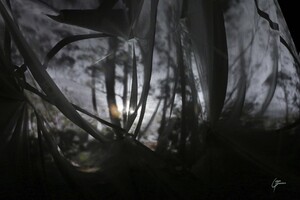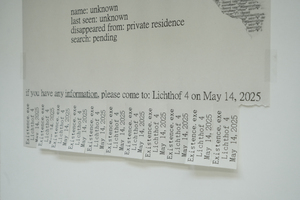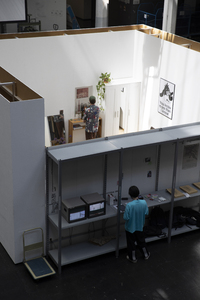"Installation"
| Begriff | Installation |
| Metakey | Kategorie (institution:project_category) |
| Typ | Keyword |
| Vokabular | HfG |
488 Inhalte
- Seite 1 von 41
ERLEBNIS THEATER: Ausstellungsansicht
- Titel
- ERLEBNIS THEATER: Ausstellungsansicht
- Autor/in
- Kategorie
- Schlagworte
- Datierung
- Mai 2021
- Ort: Institution
- Ort
- Großes Studio
- Stadt
- Land
- Titel
- ERLEBNIS THEATER: Ausstellungsansicht
- Titel (en)
- ERLEBNIS THEATER: exhibition view
- Urheberrechtshinweis
- © Carina Fenderich
- Rechtsschutz/Lizenz
- Freigabe Nutzung HfG
- Medienersteller/in
- Beziehung/Funktion
- Projektleiter/in
- Semester
- Studiengang
- Typ der Abschlussarbeit
- Importiert am
- 14.06.2024
- Übergeordnete Sets
- 1
existence.exe
- Titel
- existence.exe
- Autor/in
- Kategorie
- Typ des Projekts/Werks
- Schlagworte
- Datierung
- 14.05.2025
- Titel
- existence.exe
- Urheberrechtshinweis
- © Wei Wang
- Rechtsschutz/Lizenz
- Freigabe Nutzung HfG
- Medienersteller/in
- Beziehung/Funktion
- Projektleiter/in
- Semester
- Studiengang
- Typ der Abschlussarbeit
- Importiert am
- 18.05.2025
- Übergeordnete Sets
- 1
existence.exe
- Titel
- existence.exe
- Autor/in
- Kategorie
- Typ des Projekts/Werks
- Schlagworte
- Datierung
- 14.05.2025
- Titel
- existence.exe
- Urheberrechtshinweis
- © Wei Wang
- Rechtsschutz/Lizenz
- Freigabe Nutzung HfG
- Medienersteller/in
- Beziehung/Funktion
- Projektleiter/in
- Semester
- Studiengang
- Typ der Abschlussarbeit
- Importiert am
- 18.05.2025
- Übergeordnete Sets
- 1
existence.exe
- Titel
- existence.exe
- Autor/in
- Kategorie
- Typ des Projekts/Werks
- Schlagworte
- Datierung
- 14.05.2025
- Titel
- existence.exe
- Urheberrechtshinweis
- © Wei Wang
- Rechtsschutz/Lizenz
- Freigabe Nutzung HfG
- Medienersteller/in
- Beziehung/Funktion
- Projektleiter/in
- Semester
- Studiengang
- Typ der Abschlussarbeit
- Importiert am
- 18.05.2025
- Übergeordnete Sets
- 1
existence.exe
- Titel
- existence.exe
- Autor/in
- Kategorie
- Typ des Projekts/Werks
- Schlagworte
- Datierung
- 14.05.2025
- Titel
- existence.exe
- Urheberrechtshinweis
- © Wei Wang
- Rechtsschutz/Lizenz
- Freigabe Nutzung HfG
- Beziehung/Funktion
- Projektleiter/in
- Semester
- Studiengang
- Typ der Abschlussarbeit
- Importiert am
- 18.05.2025
- Übergeordnete Sets
- 1
existence.exe
- Titel
- existence.exe
- Autor/in
- Kategorie
- Typ des Projekts/Werks
- Schlagworte
- Datierung
- 14.05.2025
- Titel
- existence.exe
- Urheberrechtshinweis
- © Wei Wang
- Rechtsschutz/Lizenz
- Freigabe Nutzung HfG
- Medienersteller/in
- Beziehung/Funktion
- Projektleiter/in
- Semester
- Studiengang
- Typ der Abschlussarbeit
- Importiert am
- 18.05.2025
- Übergeordnete Sets
- 1
existence.exe
- Titel
- existence.exe
- Autor/in
- Kategorie
- Typ des Projekts/Werks
- Schlagworte
- Datierung
- 14.05.2025
- Titel
- existence.exe
- Urheberrechtshinweis
- © Wei Wang
- Rechtsschutz/Lizenz
- Freigabe Nutzung HfG
- Medienersteller/in
- Beziehung/Funktion
- Projektleiter/in
- Semester
- Studiengang
- Typ der Abschlussarbeit
- Importiert am
- 18.05.2025
- Übergeordnete Sets
- 1
existence.exe
- Titel
- existence.exe
- Autor/in
- Kategorie
- Typ des Projekts/Werks
- Schlagworte
- Datierung
- 14.05.2025
- Titel
- existence.exe
- Urheberrechtshinweis
- © Wei Wang
- Rechtsschutz/Lizenz
- Freigabe Nutzung HfG
- Medienersteller/in
- Beziehung/Funktion
- Projektleiter/in
- Semester
- Studiengang
- Typ der Abschlussarbeit
- Importiert am
- 18.05.2025
- Übergeordnete Sets
- 1
existence.exe
- Titel
- existence.exe
- Autor/in
- Kategorie
- Typ des Projekts/Werks
- Schlagworte
- Datierung
- 14.05.2025
- Titel
- existence.exe
- Urheberrechtshinweis
- © Wei Wang
- Rechtsschutz/Lizenz
- Freigabe Nutzung HfG
- Medienersteller/in
- Beziehung/Funktion
- Projektleiter/in
- Semester
- Studiengang
- Typ der Abschlussarbeit
- Importiert am
- 18.05.2025
- Übergeordnete Sets
- 1
existence.exe
- Titel
- existence.exe
- Autor/in
- Kategorie
- Typ des Projekts/Werks
- Schlagworte
- Datierung
- 14.05.2025
- Titel
- existence.exe
- Urheberrechtshinweis
- © Wei Wang
- Rechtsschutz/Lizenz
- Freigabe Nutzung HfG
- Medienersteller/in
- Beziehung/Funktion
- Projektleiter/in
- Semester
- Studiengang
- Typ der Abschlussarbeit
- Importiert am
- 18.05.2025
- Übergeordnete Sets
- 1
existence.exe
- Titel
- existence.exe
- Autor/in
- Kategorie
- Typ des Projekts/Werks
- Schlagworte
- Datierung
- 14.05.2025
- Titel
- existence.exe
- Urheberrechtshinweis
- © Wei Wang
- Rechtsschutz/Lizenz
- Freigabe Nutzung HfG
- Medienersteller/in
- Beziehung/Funktion
- Projektleiter/in
- Semester
- Studiengang
- Typ der Abschlussarbeit
- Importiert am
- 18.05.2025
- Übergeordnete Sets
- 1
existence.exe
- Titel
- existence.exe
- Autor/in
- Kategorie
- Typ des Projekts/Werks
- Schlagworte
- Datierung
- 14.05.2025
- Titel
- existence.exe
- Urheberrechtshinweis
- © Wei Wang
- Rechtsschutz/Lizenz
- Freigabe Nutzung HfG
- Medienersteller/in
- Beziehung/Funktion
- Projektleiter/in
- Semester
- Studiengang
- Typ der Abschlussarbeit
- Importiert am
- 18.05.2025
- Übergeordnete Sets
- 1











